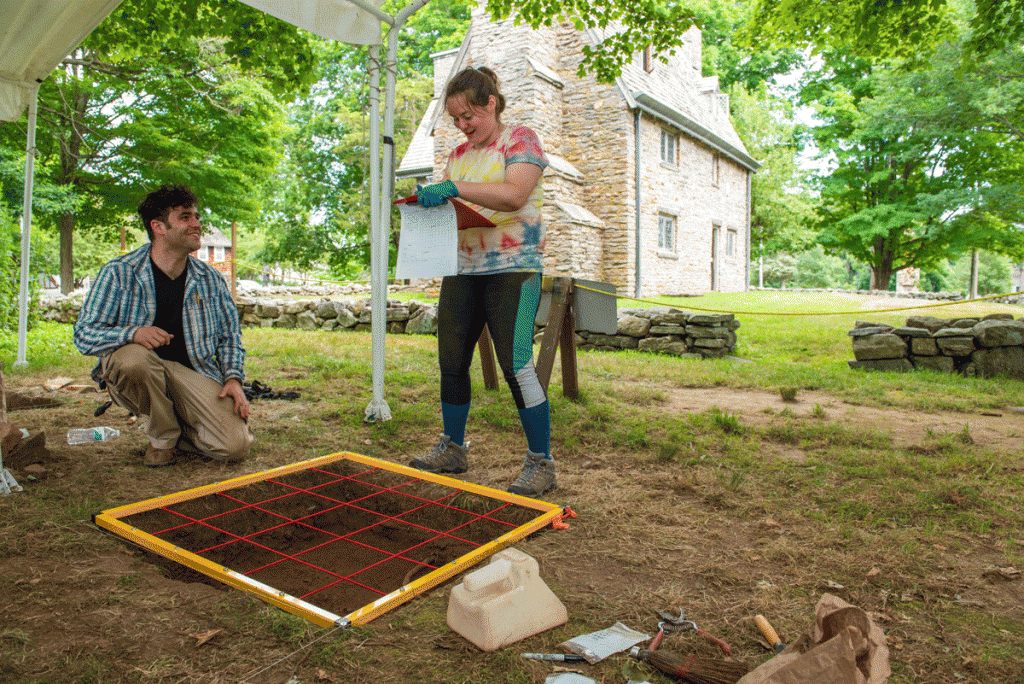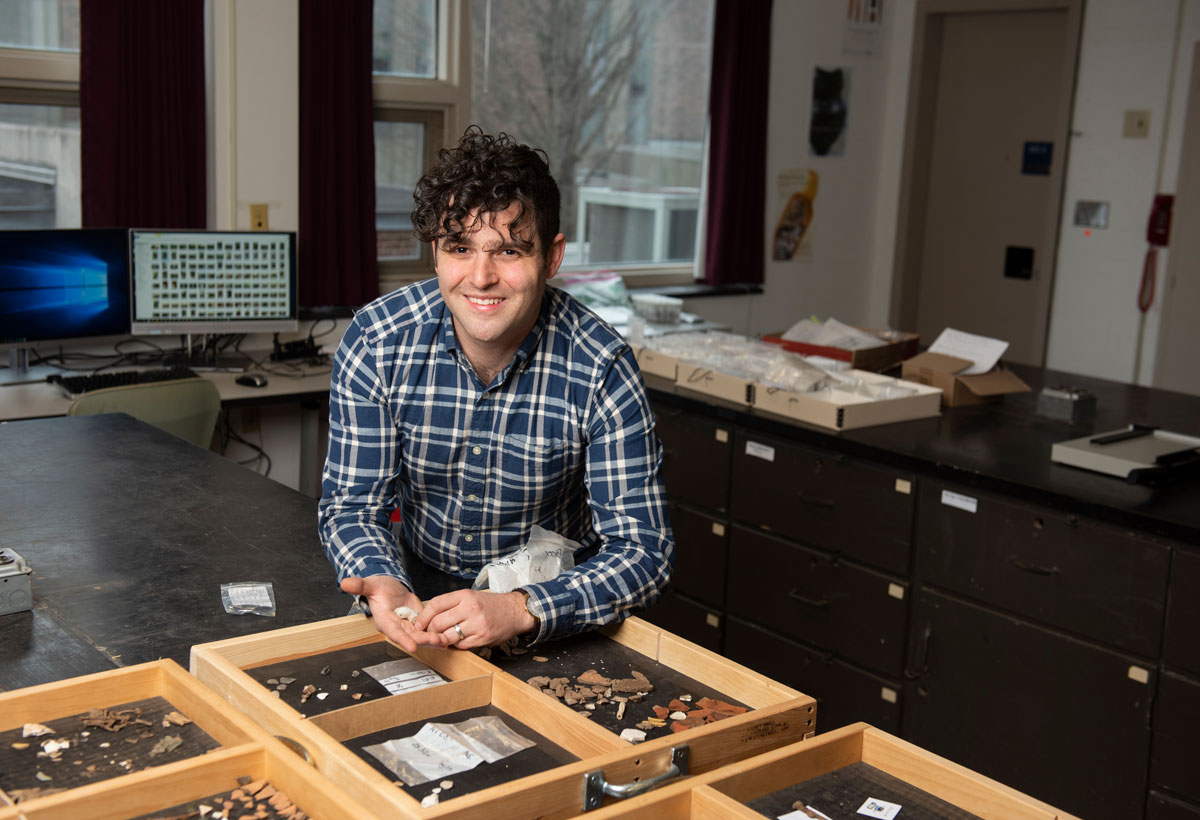When humans invented agriculture some 10,000 years ago, it forever changed how people worked and lived. In just about every place in the world where agriculture took hold — from Mesopotamia to Mesoamerica — small, transient hunter-gatherer tribes morphed into villages and large cities.
With these new, bustling settlements came sweeping cultural changes, new social hierarchies and, often, vast extremes of poverty and wealth. (Think pharaohs and slaves; kings and commoners.)
Except, that is, in New England.
In fact, around 1,000 A.D., when maize agriculture migrated here from Central Mexico and the Southwest, life seemed to go on pretty much as usual. Or so archaeologists thought.
Now, new research conducted by Assistant Professor of Anthropology William Farley is challenging that assumption. In a paper published last April in American Antiquity, Farley and coauthors Gabriel Hrynick and Amy Fox highlight a pattern of architectural changes that coincide with the arrival of maize farming in New England — shedding new light on a mystery that has stumped archaeologists for decades.
“The answer isn’t what people thought before, which is that maize came into the region and nothing happened,” Farley says. “The changes are subtler than in places like Mesopotamia, where you had 50,000 people living in a city. But we do start to see these subtle changes in houses. And from research we know that houses tend to strikingly reflect cultural values.”
Like so many good ideas, Farley’s was born on the back of the proverbial cocktail napkin, over drinks with Hrynick, a former University of Connecticut classmate, now also an archaeologist. The two were attending a conference and, having reconnected at a hotel bar, were deep in conversation, pondering age-old questions about the arrival of agriculture in New England — and its seemingly negligible influence on society.
“Why does New England look so different from other parts of the world? Why can’t we find these villages?” Farley recalls asking. Although some early European settlers describe encountering villages in the region, archaeologists have never found any evidence, Farley explains.
The talk was a serendipitous meeting of the minds. Farley is an archaeobotanist (he studies the interconnection of plants and humans), while Hrynick’s wheelhouse is architecture. Farley’s geographic focus is southern New England; Hrynick’s is northern Maine and Canada’s Maritime Provinces.

Farley recalls the conversation: “We were talking about different sites in the region and Gabe [Hrynick] said, ‘You know, the houses stayed really small in the North.’” Unlike southern New England, the North adopted agriculture only after Europeans arrived.
In contrast, Farley observed that in southern New England, where he had worked on archeological digs, some of the houses grew larger during later periods. Could it be a pattern? And could maize farming be the reason for the shift?
“Maybe we should explore that,” he remembers thinking. It took a setback — one that threatened to derail Farley’s Ph.D. ambitions — to catapult the idea from barroom brainstorm to bona fide research project.
In January 2017, around the same time he was offered a full-time teaching job at Southern to start the following fall, Farley was diligently plugging away at his doctoral dissertation when his research came to a standstill. “I lost half of my data,” recalls Farley, a UConn grad student at the time. “I was looking at this site from Massachusetts, and the people who controlled the data told me I couldn’t use it anymore.”
He had six months to complete his dissertation. “I was in crisis mode,” says Farley. Forced to find a new topic, he called his friend Hrynick, now a professor at the University of New Brunswick in Canada. “Hey, do you want to write that paper together that we talked about that time at the bar?” Farley asked him.
And so the archeologists joined forces. They later recruited Fox, a Ph.D. student at the University of Toronto and a “brilliant mathematician,” says Farley, to help with the statistical analysis.
Although their research examined more than 100 archeological sites from New York City to Newfoundland, “we didn’t move a spoonful of dirt,” Farley says. Instead, he spent eight hours a day for nearly two months in libraries around the region, poring over more than a century’s worth of often-obscure archaeological literature.
“Anytime anybody had excavated a house, a wigwam, a pre-European Native American house, we were going to measure them,” Farley says.
After he amassed and crunched all the data, an interesting pattern emerged. In the Maritime Peninsula, where agriculture had not taken hold, houses stayed the same size and shape — small and round — for some 3,000 years. The same was initially true in southern New England — until about 1,000 years ago, when bigger, more elongated houses appeared.
“Things changed right at the same instant, archeologically speaking, that maize arrived in the region. You got a bifurcation of the data,” says Farley.
He can’t say exactly why the shift occurred. “It could be that a social hierarchy is emerging. It could be changes in labor practices,” he says. “I don’t think we’ve got enough data to say for sure. But I think there’s evidence that when maize agriculture arrived, society started changing,” he says. Seeing his work published in American Antiquity, the premier academic journal for American archaeology, marked a major career milestone for Farley, who is 33.
“It really was a bit of a lightning strike — a combination of Gabe’s and my interests,” he says. “This was a nagging question that archaeologists have been interested in for many decades in New England. We took a different approach than anyone has ever used before. We just got a little bit lucky that it worked.”


